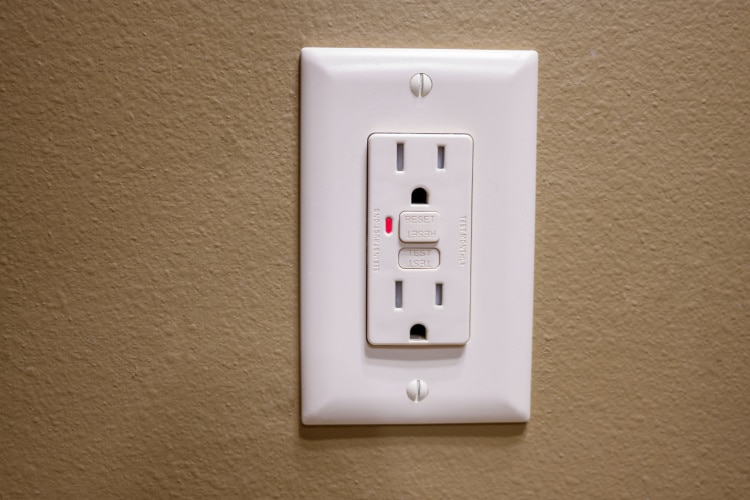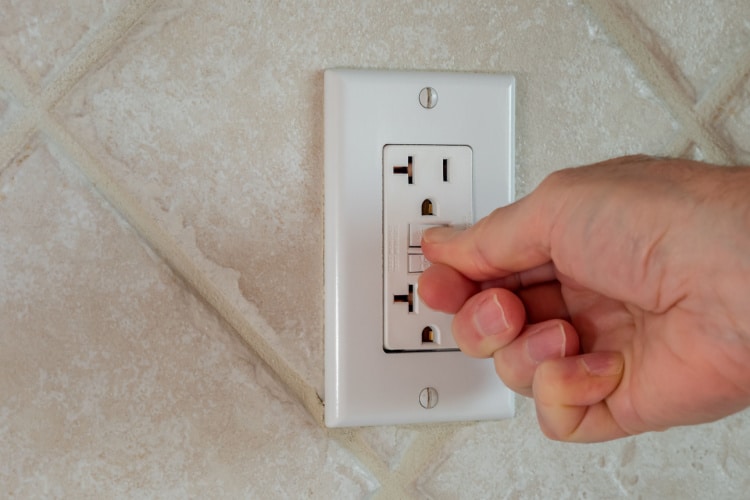GFCI outlets play a significant role in our everyday lives — they protect us from electrical shock.
However, GFCI receptacles, like any other electrical device, can fail or lose their efficacy over time. As a result, it’s critical to test them to ensure they’re working correctly.

Testing your GFCI outlets will give you the peace of mind that you are protected from an electrical disaster — and it’s easy to do so! In this article, we’ll look at the four best ways to test your GFCI receptacles.
The Protective Ability of a GFCI Outlet

A Ground Fault Circuit Interrupter (GFCI) outlet is designed to protect against electrical shock. It’s usually installed in areas where water and electricity may come into contact, such as bathrooms, kitchens, and outdoor spaces.
A GFCI outlet keeps track of the circuit’s electrical current movement by continuously monitoring the flow of the current through the circuit’s hot and neutral lines.
When an electrical circuit operates properly, the hot and neutral wires carry the same current quantity. If they don’t, then this indicates that a portion of the current is leaking. The GFCI detects this change in the electrical flow and instantly cuts off power to the outlet to avoid electrical damage or electrocution.
How Long Does a GFCI Outlet Last?
The lifespan of a GFCI outlet varies depending on several factors, such as the product’s quality, frequency of use, and the environmental conditions it’s exposed to. Generally, a GFCI outlet lasts up to 15 years or more.
However, it’s important to note that the functionality of a GFCI outlet deteriorates over time due to factors such as wear and tear, power surges, or exposure to moisture and extreme temperatures. So, it’s recommended to test GFCI outlets periodically and replace them if they’re not working correctly.
Signs of a Malfunctioning GFCI Outlet
Several signs indicate that a GFCI outlet is malfunctioning.
The main sign is its inability to provide power. If you plug in a device and it does not receive power from the socket, the GFCI outlet is faulty.
If the GFCI outlet has power but trips frequently without an apparent cause, you may be dealing with a wiring problem or a problem with the outlet itself.
If the GFCI outlet doesn’t trip when it should, that’s another indication of a malfunctioning GFCI. This issue may be a safety hazard, as the GFCI is designed to protect against electrical shocks and fires.
Lastly, if you notice any burn marks or physical damage on the GFCI outlet, this could be a sign that it’s malfunctioning or has been damaged due to an electrical surge.
How to Test a GFCI Outlet

If you notice any of the above signs, it’s time to test if the GFCI outlet is malfunctioning.
However, even if you don’t notice any of the signs listed above, it’s still a good idea to inspect your GFCI receptacle occasionally to ensure everything works as it should.
So, let’s learn how to inspect it. Here are the four most effective ways to test a GFCI outlet.
1. “TEST” Button
Every GFCI receptacle has “TEST” and “RESET” buttons. These buttons are located in the center of the outlet. The “TEST” button is typically black, while the “RESET” button is usually red.
Both of these buttons are intended to test the GFCI outlet’s effectiveness. To do that, first press the “TEST” button. If the GFCI outlet is working correctly, it should instantly stop providing electricity to the outlet.
To prove this, plug in any gadget you have nearby, such as a night light. Once you’ve verified that the outlet’s power has been turned off, hit the “RESET” button to turn it back on. If you are unable to restore electricity, the GFCI outlet is defective.
2. GFCI Tester
A GFCI tester is a small portable tool used to test whether the GFCI outlet is properly wired and functioning correctly.
The GFCI tester has three prongs that you should plug into the GFCI receptacle slots. The tool also features a LED indicator that tells whether the outlet is wired, grounded correctly, and functioning. Some versions may also have audible alerts to warn you of a problem.
To test your GFCI outlet using this tool, insert it into the GFCI outlet and monitor the indicator lights. If the lights indicate the outlet is not wired correctly, or the GFCI protection is not working, you should repair or replace the outlet.
3. Multimeter
A volt-ohm meter (VOM), also known as a multimeter, is a portable electronic instrument used to measure the voltage, current, and resistance of various electrical circuits, like the ones found in GFCI outlets.
A multimeter has a monitor screen, a dial or selection button to pick the measurement method, and two probes. The probes are plugged into the GFCI outlet, enabling the multimeter to measure and show the outlet’s electrical characteristics.
To test the GFCI outlet, set the multimeter to measure AC voltage and plug the probes into the GFCI outlet. The multimeter should show around 120 volts of electricity.
Then, hit the “TEST” icon on the GFCI outlet. The multimeter’s voltage measurement should drop to zero, showing that the GFCI outlet is operational. To end the test, press the “RESET” option to turn the power back on, and the multimeter should read 120 volts again.
4. Circuit Tester
A circuit tester is a tool to check the existence of electrical power in an outlet.
A circuit tester comprises a handle, a probe, and a light or digital monitor. The probe goes into the electrical sockets of an outlet, and if the circuit is working correctly, a light or a computer readout will light up.
To test the GFCI outlet, press the “TEST” button to cut off the power and then press the “RESET” button to resume power. You should then plug the probe into the “hot” and “neutral” receptacles.
If the circuit tester lights up or you see the voltage rating (typically 120 volts) on the monitor, the GFCI outlet is fully operational.
How to Maintain a GFCI Outlet
Maintaining a GFCI outlet is essential to ensure its safety and functionality. Here are some tips for maintaining your GFCI outlet:
Test your GFCI outlet every month to ensure it’s working as expected.
Keep the GFCI outlet clean and dry. Use a soft cloth or brush to clean the outlet regularly, and make sure the power is off and the outlet is dry before plugging anything into it.
Don’t overload the outlet. This can cause it to overheat, trip the circuit, and fail to function appropriately.
If your GFCI outlet is old or showing signs of wear and tear, it’s time to replace it. This job is best left to a licensed electrician, who can ensure the replacement is done safely and correctly.
Conclusion
Defective GFCI receptacles increase the risk of electrical shocks and fires, so knowing how to test them correctly is an essential habit every homeowner should practice.
This article covered several ways to test a GFCI outlet, including using the “Test” and “Reset” buttons, a GFCI tester, a multimeter, and a circuit tester.
Each approach has its perks, and selecting the one best suited to your specific needs is critical. Test your GFCI outlets frequently and follow the maintenance guidelines we’ve provided.
If you struggle to complete this test on your own, please call a qualified electrician for expert guidance and assistance.